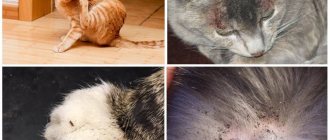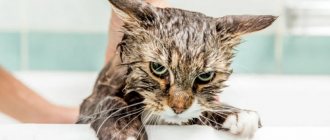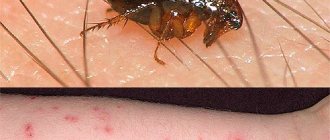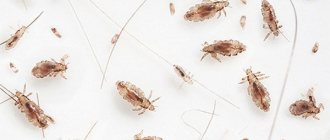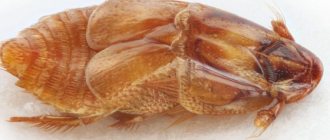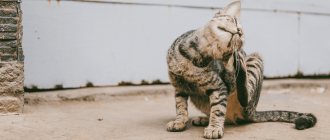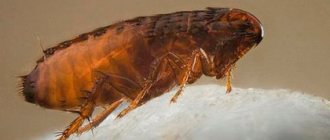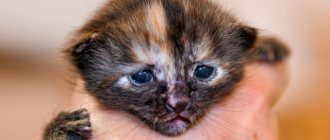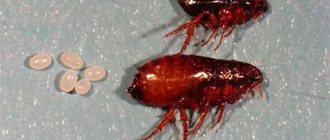Flea infestation is an almost inevitable phenomenon, so preventive and therapeutic measures should be applied at intervals of once every 2 to 3 months. Manufacturers of veterinary products provide a lot of antiparasitic products: collars, sprays, shampoos, drops.
These products are mainly aimed at healthy adult pets. With newborn kittens, as well as cats in a special situation, everything is much more complicated. And the question of how to remove fleas from a pregnant and lactating cat is quite acute for animal owners.
Signs and routes of infection
Understanding whether a cat or newborn kittens have fleas is not a tricky matter; the main thing is to pay attention to a number of signs in time:
- itching;
- the appearance of wounds and scratches on the body;
- nervous behavior;
- traces of flea activity on the animal’s body;
- hair loss;
- baldness.
Fleas are jumping, hardy insects that can live without food, waiting for a new owner, for up to 18 months. And if a blood-sucking insect is hiding in the grass, then a cat passing by will undoubtedly be infected. Even if the pet has not been outside, insect eggs and larvae can be carried on the shoes or clothes of household members.
Flea
One flea on a cat's body is enough to create a population of blood-sucking fleas within two weeks. The parasite does not lay eggs in one place, but sprays them in different places, so they can end up on bedding, furniture, and the floor.
And you shouldn’t be surprised if a pregnant cat, which never leaves the apartment, or newborn kittens suddenly develop fleas.
Criterias of choice
When choosing a flea collar for your cat, you should pay attention to the following points:
- Consumers quite often pay attention first of all to the price tag of a product. It can be tempting to buy the cheapest accessory. But you shouldn’t do this, because a quality product cannot be too cheap. At the same time, the best flea collars do not always have the highest price. It is best to purchase flea straps that are of average cost.
- Protective straps should be selected taking into account the age category of the cat and its physiological condition. For adult cats, cats bearing offspring, or small kittens, there is a range of products that differ in size and concentration of active ingredients.
- It is important to study information about the material of the strap and the components with which the protective product is impregnated. Preference should be given to those straps whose impregnation includes compounds with low toxicity. In this way, you can protect the animal from negative consequences that can significantly harm the animal’s health. It is important that the concentration of amitrazome, permethrin or organic phosphates does not exceed 15%.
In addition, the flea protective accessory must correspond to the size of the animal’s neck.
On average, the length of the product can be 35-40 cm. Using a special fastener on the tape, the strap can be correctly secured to the animal’s neck and, if necessary, adjusted in volume.
From what age
When choosing a flea collar for a kitten, you should remember that their use is not recommended for animals that are not yet 2 months old. At the same time, it is strictly forbidden to use a flea collar intended for adult animals, since the concentration of active substances contained in them is safe for cats and cats, and a kitten can be poisoned.
When choosing a product for a kitten, you should especially carefully examine the retainer. It should be as safe as possible and be able to easily unfasten if an active animal gets caught somewhere in the product. This safety criterion when putting on will protect the baby from sad consequences.
Is it possible for lactating animals
A flea collar is not recommended for a nursing cat. The insecticide with which the tape is impregnated has a prolonged effect and can cause severe poisoning in kittens or even lead to death. To treat a lactating cat against fleas, you can use Frontline drops.
Manufacturers
There is a wide choice of antiparasitic devices.
Products from the following manufacturers are popular among consumers:
- Hartz products. Hartz products have many supporters who value quality and a good range. Hartz straps are resistant to various external factors (moisture) and effectively eliminate blood-sucking parasites.
- Bolfo products. Bolfo accessories are water resistant. They may vary depending on the weight of the animal. This is very practical, since for a large cat you can select a product with the required concentration so that it is no less effective than on a small individual.
- Beaphar products. Beaphar products are preferred by supporters of organic products. The strap is impregnated with an insecticide based on margosa extract. Such a substance is not capable of causing harm to the animal, which allows their collars to be used for the smallest kittens (from 1.5 months).
Collars against blood-sucking leopards are a fairly effective domestic product, which is in no way inferior to imported analogues. It protects not only from cat fleas, but also from ticks.
How to detect?
Fleas live on the kitten's neck and back, so a thorough examination should begin from there. Insect bites cause itching, so you should look for scratches and wounds.
You can see black lumps on the kitten's undercoat - these are traces of flea activity. To make sure they are present, you can rub the animal’s back on a white paper towel. The presence of red-brown marks will confirm fears that this is feces containing undigested blood.
The behavior of kittens may indicate the presence of parasites: the animals behave nervously, are frightened by any rustling sounds, and do not want to play. If a mother cat itches intensely and chews insects with her teeth, this also indicates the presence of fleas.
Symptoms of cat fleas
If there are too many fleas, then it will not be difficult to detect them with the naked eye - they will run around the kitten’s belly, behind its ears and armpits. If fleas have not had time to breed, they are difficult to detect and the following symptoms will indicate their presence:
- The kitten is acting restless;
- Due to the itching from bites, the pet constantly itches with its paw behind the ear and can gnaw fleas out of its fur;
- Bites are visible in the form of red spots and wounds;
- In the kitten's frequent habitat and on its fur, flea excrement can be found in the form of small black dots less than a millimeter in diameter;
- In the presence of parasites, dermatitis and allergies may occur;
- Weight loss.
IMPORTANT: When fleas are detected, you should not run to the veterinary pharmacy and buy the first remedy you come across. It is necessary to select a method for destroying parasites based on the age of the kittens and the danger of the product for babies.
Features of ridding a pregnant and lactating cat of fleas?
A pregnant cat is especially vulnerable, since the body's strength is spent on bearing babies, so parasites can cause irreparable harm to it.
The rescue procedure requires some effort and knowledge, since not all means are suitable, and traditional methods can harm future offspring.
If a nursing cat has fleas, then everything is even more complicated, since the animal is in constant contact with kittens, which are very sensitive to various veterinary drugs.
Features of the insect
What are fleas? These are blood-sucking parasites. They are quite unpretentious and tenacious. Squashing a flea is not easy because of its body structure. The parasite has legs designed for jumping long distances. Fleas can go without food and survive for weeks this way. These insects are very prolific, which also poses a serious problem.
What do fleas look like and why are they dangerous?
Fleas have a mouthpart that allows them to bite through the skin of an animal and feed on its blood. Thanks to their laterally flattened body and small, rounded head, insects can move quickly through cat fur. On the surface of the flea's body there are bristly ridges, which also help the parasite cover distances on the animal's body. The flea has six legs, the back two of which are especially well developed. This allows fleas to jump up to half a meter.
These parasites pose a serious danger primarily to kittens, as well as weakened, sick and old animals. Fleas can cause anemia in kittens because one parasite drinks large amounts of blood. In the most advanced cases, fleas can lead to the death of the animal.
In addition to the fact that fleas feed on the blood of animals, they are also carriers of many dangerous diseases. For some types of helminths, fleas are an intermediate host. An animal can accidentally swallow a flea and then the helminth eggs enter the body directly, where they become larvae and then turn into adult parasites.
At the same time, the cat’s skin and fur also suffer greatly. The coat may fall out, lose shine and look unkempt.
Types of fleas in cats
The most common flea that affects cats is C felis, also known as the cat flea. The size of parasites of this species is small - from 2 to 4 mm. They do not have wings, and their small head and laterally flattened body allow them to easily move among the cat’s fur, clinging to the hairs with bristles and spines.
Where do fleas come from?
Fleas are parasites that are active all year round. They live not only on the street, but also in the basements of residential buildings and entrances. You may not even notice the larval eggs hidden in the corners of your apartment: behind baseboards, in cracks, in furniture and folds of linen. The larvae feed on dust and other contaminants, and then, upon reaching sexual maturity, migrate to a pet. Therefore, even a domestic cat can become infected with parasites that you accidentally brought from the street on your clothes or shoes.
Symptoms of flea infestation
You won't be able to avoid noticing fleas on your cat for a long time. The animal quickly begins to show the following signs of the disease:
- An infected cat begins to actively scratch and bite itself, trying to catch parasites.
- The animal is nervous and meows.
- Black crumbs on the skin are parasite excrement and dried blood from scratching bites.
- When examining the cat's back or scruff, you may notice bite marks.
- The presence of fleas themselves on the animal’s fur.
Are fleas the same on dogs and cats?
It happens that dogs and cats suffer from the same type of fleas. Dogs and cats can be parasitized by a specific type of parasite - the cat flea. At the same time, there is also a dog flea, which parasitizes exclusively on dogs.
How often can fleas be poisoned?
The procedure for killing fleas using special drops is carried out once. If necessary, the procedure is repeated after two months. At the same time, the room is treated with special means: the floor, baseboards and the animal’s sleeping area.
Bathing and mechanical methods of control
Bathing, as a method of combating fleas in a pregnant cat, can only be suitable if the animal is accustomed to water procedures, otherwise it will cause stress and harm the mother and offspring. If shampoo treatment has been used previously, then this method is quite suitable.
Bathing
Rules for treating flea shampoo:
- For swimming you need warm water, 37 – 39 0C.
- The bottom of the sink, bathtub or basin should be covered with a towel, the cat will be able to cling to it with its claws, and it will be calmer.
- You need to prepare several terry towels that absorb moisture in advance.
- The shampoo does not need to be used in its pure form, but rather diluted in a small amount of water according to the instructions.
- When the fur gets wet, fleas can rush to where it is dry, that is, to the head, which should not be wet. To prevent this, you need to first soap your neck, this will create a protective barrier.
- The foam should remain on the fur for 5 - 7 minutes so that the animal does not break out, you can wrap it in a towel and carry it in your arms.
- The shampoo must be thoroughly rinsed with running water.
Pet owners are wondering whether it is possible to treat a nursing cat with flea shampoo. The answer is no, because particles of the insecticidal agent contained in the shampoo remain on the fur. Kittens, while feeding, are in close contact with their mother, so the toxic substance can harm them.
A safe way to combat blood-sucking insects is to comb out with a fine comb. This is a labor-intensive and time-consuming process, but it will help remove fleas from a pregnant and lactating cat.
Directions for use and precautions
Flea collars should be used as directed.
Having taken it out of the package, it is put on the animal and secured with a retainer. In this case, the product should be located quite tightly to the neck, but the cat should not experience discomfort. It should be possible to fit an adult's finger between the pet's neck and the strap.
The protective product should be on the cat at all times, but bathing animals with a collar is not recommended. If, according to the instructions, the product needs to be worn for 5-6 hours during the day or only during the day (it is removed after use and remains effective at night), then the collar is placed in a plastic bag so that the active ingredients do not erode.
In addition, you must take into account the following precautions when using such an accessory:
- During the entire period of use of the flea protection strap, it is not recommended to use other antiparasitic drugs or agents. Otherwise, the animal may be poisoned by an excess amount of insecticidal substances.
- You should monitor your cat's reaction to wearing a collar, since the insecticide can cause an allergic reaction in particularly sensitive cats.
- If your pet develops dermatitis, the protective product should be immediately removed, and the area where the strap comes into contact with the cat’s skin should be carefully washed with soap.
- If the allergic reaction is severe, then the animal needs to be shown to a veterinarian and be sure to change the brand of collar.
- After the owner puts such a product on his pet, he should wash his hands thoroughly.
- The cat should not be allowed to lick the collar or its individual parts, as this can cause serious poisoning of the animal.
The pet owner must not only understand how to put on a flea collar, but also take into account how long the flea collar lasts. The shelf life of the collar itself can reach 6-7 months. After this period of time, the product will no longer be effective and should be replaced.
Other means
The following brands of flea drops work well for treating pregnant and lactating cats:
- Advantage (Advantage) 40. The active ingredient is imidacloprid, it protects mother and babies, as it has an “umbrella effect”. Apply to the skin between the shoulder blades so that the cat cannot lick the drug.
- Frontline Combo. The active substances are fipronil and S-methoprene, applied to the withers. The drug is fast-acting with a long-lasting effect.
- Beaphar (Beafar) - drops against fleas and ticks. A natural preparation based on an extract from the Neem (Margosa) tree. It has no contraindications, with the exception of an allergic reaction.
Tablets and injections are a last resort in case of severe infection, which can only be used in a veterinary clinic under the supervision of doctors.
Traditional methods are good for prevention, since their effectiveness is negligible. But to calm down, you can make a decoction of nettle, eucalyptus, lavender, tansy and spray it on a pregnant cat, this will repel fleas from her for a while.
When the kittens reach 3 to 4 weeks of age and can go without food for several hours, the cat can be removed and treated with an insecticide that quickly absorbs into the skin, killing fleas. In this case, they will not harm the babies and the nursing cat itself.
Baby
When treating an animal, you must not forget about treating the pet’s area, in which insect eggs and larvae may remain. If it is winter outside, then it is advisable to take the bedding and the house out into the cold for a while.
For prevention, you can place a bag of eucalyptus or fragrant herbs next to the bed:
- wormwood;
- lavender;
- tansy.
Does it help?
When pet owners are interested in whether flea collars help cats and whether it makes sense to purchase one, they need to become familiar with the strengths of such devices.
They are as follows:
- there is no need to simultaneously carry out special hygiene procedures (use sprays or shampoos, as well as combing);
- a cat wearing such an accessory will not bring parasites after walking outside, and drops or other means do not provide such a guarantee;
- such an accessory is universal and can repel fleas, lice, ticks or reduce their activity;
- special products are suitable for use by pregnant cats or kittens;
- the protection period is quite long (up to 6 months);
- wide range of protective products;
- various price categories;
- minimal risk of overdose of toxic substances;
- An animal walking on the street is immediately positioned as a pet with such an accessory.
The effectiveness of the collar against fleas can be observed after 2-3 days from the start of its use. When choosing a means of protection against bloodsucking for their pet, owners should take into account various factors: age, temperament and the general health of their pet. If this is possible, you should first consult a veterinarian, who will inform you in detail about how flea collars work.
How to remove fleas from small kittens?
If the mother is infected, then newborn kittens also have fleas, this is inevitable. Insecticides can be used by kittens at the age of 8 weeks, and if the baby has a weak immune system, then from six months.
If the kitten is only 1 week old and has fleas, you can get rid of blood-sucking insects using gentle methods, such as shampoo. In any case, no matter how harmless the product is to health, the treatment is carried out only when the baby opens his eyes, this usually happens in the first week after birth.
A fairly safe, but labor-intensive method of getting rid of fleas is to comb out the parasites with a fine comb. To do this, you need to prepare a container of water, and, holding the kitten over it, you need to carefully run the comb through the fur. Fleas, if present, will fall into the water.
If fleas in newborn kittens, despite the efforts made, continue to multiply so that the owners give up and it is not clear what to do, then as an option you can resort to such a more effective method as bathing. To achieve this, gentle means are used:
- foam of tar or baby soap;
- a weak solution of shampoo for kittens;
- decoction of herbs (chamomile, tansy, wormwood).
Kittens should be bathed in warm water and a warm room so that the baby does not become hypothermic. After dipping the baby into the water, you need to gently rub the foam into the fur, avoiding getting it into the eyes and mouth. It is advisable that the soap solution remain on the skin for one minute, after which you can wash off the product. After thoroughly drying the kitten with a terry towel, you can put it on a heating pad until completely dry, and only then return it to its mother.
What is the danger of parasitic insects?
No one is protected from fleas. For an innumerable number of these parasites to appear in your apartment, it is enough to bring in one such bloodsucker. At the same time, it is not at all necessary that the pet come into contact with a flea-bearing animal. A flea can “arrive” on your shoes or on the paws of any pet.
Fleas carry a large number of diseases that pose a threat to both cats and people. We can highlight the main and most common health problems that can arise from these insects:
- Allergic reactions. Some cats are allergic to flea saliva. In this case, the animal will itch even more. And if the allergen is not eliminated in time, then such proximity in some cases leads to hair loss and the formation of scabs on the cat’s body.
- Worms. Fleas carry the eggs of parasites such as pinworms, roundworms, and flukes. While licking its fur, the cat swallows a considerable number of these eggs. And in kittens and weakened animals, helminthic infestation in some cases leads to death.
- Anemia. In advanced situations, long-term coexistence of an animal with fleas leads to anemia in the pet (decreased hemoglobin in the blood).
Human contact with fleas is dangerous because these insects can be carriers of serious diseases. One bite of such parasites can infect a person:
- worms;
- salmonellosis (acute intestinal infection of animals and humans caused by salmonella);
- encephalitis (an inflammatory process affecting the brain);
- typhoid (an infectious disease accompanied by mental disorders against the background of severe fever and intoxication);
- tularemia (an acute infection that affects the lymph nodes, skin, lungs, and sometimes the mucous membranes of the eyes and pharynx);
- brucellosis (a dangerous infection that affects all systems of the body).
One flea bite can lead to many diseases
Preventing flea infestation
Doctors like to repeat that disease is easier to prevent than to treat. This statement is also true for flea infestations. It is much better to prevent fleas from appearing on your cat at all than to remove them over the course of several months.
There are folk methods of repelling fleas - various herbs and essential oils, but in practice only modern insecticides can prevent infection. They use drugs that kill fleas after they attack an animal. Sufficiently effective repellents for cats - insect repellent drugs - do not yet exist.
Regular treatment of pets is necessary throughout the warm season. This time interval is different for different regions. Year-round prevention is required for free-ranging cats, since they come into contact with stray relatives and can wander into a warm basement infested with fleas.
Thorough washing of shoes immediately upon returning home, regular cleaning of the hallway and periodic washing of beds will help reduce the risk of infection for apartment cats. Or preventive treatment of the animal with modern drugs against external parasites.
Eliminating the consequences of infection
To eliminate the consequences of flea infestation in the form of bites, you can use folk remedies. First you need to disinfect the bite sites with iodine, alcohol or antibacterial soap. Then you can apply a piece of ice or gauze soaked in cold water to the bite site. A longer lasting result is achieved by using Fenistil gel or Psilobalm. In addition to them, you can use tea tree oil, strong tea leaves or chamomile decoction. Soak a cotton pad in the liquid and apply to the bite areas.
